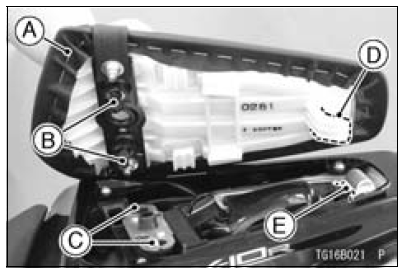


A. PassengerŌĆÖs Seat
B. Projections
C. Holes
D. Tab
E. Slot
 RiderŌĆÖs Seat Installation
RiderŌĆÖs Seat Installation Tool Kit
Tool KitRadiator and Radiator Fan Removal
Remove:
Upper Fairing Assembly (see Upper Fairing Assembly
Removal in the Frame chapter)
Coolant (Drain, see Coolant Change in the Periodic
Maintenance chapter)
Air Cleaner Housing (see Air Cleaner Housing Removal
in the Fuel System (DFI) chapter)
Coolant Reserve Tank (see Coolant R ...
Alternator Inspection
There are three types of alternator failures: short, open
(wire burned out), or loss in rotor magnetism. A short or
open in one of the coil wires will result in either a low output,
or no output at all. A loss in rotor magnetism, which may be
caused by dropping or hitting the alternator, by leav ...
Front Fork Removal (Each Fork Leg)
Loosen the front fork top plug [A] beforehand if the fork
leg is to be disassembled.
Special Tool - Top Plug Wrench (45 mm) [B]: 57001-1741
NOTE
Loosen the top plug after loosening the handlebar
clamp bolt [C] and upper front fork clamp bolt [D].
Remove:
Upper Fairing Assembly (see Up ...